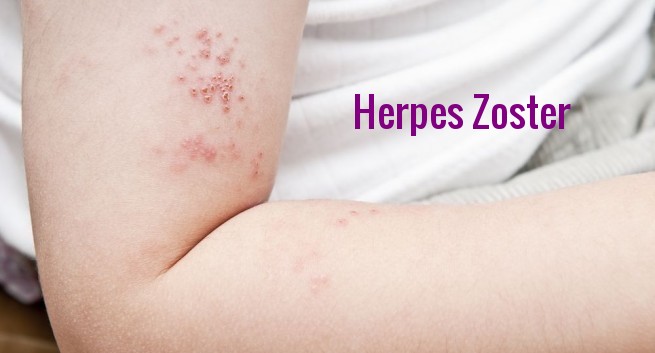Herpes zoster
Herpes zoster is a viral disease characterized by a painful skin rash with blisters involving a limited area. Typically the rash occurs on either the left or right of the body or face in a single stripe. Two to four days before the rash occurs there may be pain or tingling in the area.
SYMPTOMS
The earliest symptoms of shingles, which include headache, fever, and malaise, are nonspecific, and may result in an incorrect diagnosis. These symptoms are commonly followed by sensations of burning pain, itching, hyperesthesia (oversensitivity), or paresthesia (“pins and needles”: tingling, pricking, or numbness). Pain can be mild to extreme in the affected dermatome, with sensations that are often described as stinging, tingling, aching, numbing or throbbing, and can be interspersed with quick stabs of agonizing pain.
COMPLICATIONS OF HERPES
Ear Complications (Herpes zoster oticus):
- Herpes zosterinvolving the facial nerve produces the Ramsay Hunt syndrome, which is characterized by intense pain in the ear; herpetic vesicles on the external ear or tympanic membrane, mouth, face, neck, and scalp and transitory one-sided facial paralysis.
- This syndrome is occasionally associated with vertigo, tinnitus, and hearing disorder.
Eye Complications:
These occur when the virus affects the ophthalmic division of the trigeminal nerve.
- Development of corneal surface erosions and ulcerations.
- Decreased sensation of the cornea, decreased tears, late healing and increased risk of corneal injury.
- Increased risk of bacterial infectionin the eye
- Zoster uveitis which is a very serious condition that leads to severe eye complaints and pathologies like atrophy of the iris, irregular pupil, corneal edema, formation of cataract and glaucoma too
- Acute retinal necrosis vcausing blurring of vision and/or pain in one or both eyes.
- In a more severe form, there is absence of light perception and detachment of the retina. This condition has a very poor prognosis.
- Optic neuritisor inflammation of the optic nerve
- Glaucoma usually seen in patients with severe, chronic or repeated attacks of shingles
- Cataract also usually seen in patients with severe, chronic or repeated attacks of shingles
Post Herpetic Neuralgia (PHN):
- Characterized by constant or intermittent continuation of pain that accompanies the acute episode of shingles. This is the most common complication following shingles.
- Especially seen in older and may persist for weeks or months after the sores have healed. The pain can be severe enough to be incapacitating especially in elderly persons.
- In cases of severe or persistent pain, patients can become depressed and on occasions may even become suicidal.
Secondary Infection:
- Secondary bacterial infection of the blisters with streptococci or staphylococci can occur after 1-2 weeks with yellowish crusting or discharge from it.
- Cellulitis is common with the affected area becoming erythematous, tender, firm and hot. Red streaks may appear around the wound.
Central Nervous System Complications:
These usually occur in immunocompromised individuals and include conditions like:
- Meningoencephalitis,e., inflammation of brain and its coverings, resulting in delirium, confusion or coma
- Myelitisor inflammation of the outer covering membrane of the nerves
- Cranial nerve palsiesor weakness
- Peripheral facial nerve palsy
- Cerebrovascular accident such as stroke
HOMOEOPATHIC TREATMENT
Homeopathy can effectively treat Herpes zoster. If patient comes early he can get results in few days. Homeopathic medicines reduce the intensity of pain, burning and subsequently reduce infection, and shorten the duration of infection. Relapses are also prevented by homeopathy. Homeopathy is also very effective in the cases of Post-herpetic neuralgia. Homeopathy is strongly advocated in the cases of Herpes Zoster.

